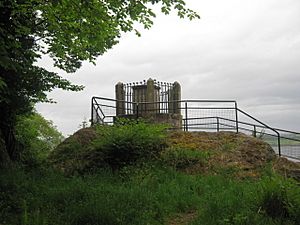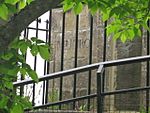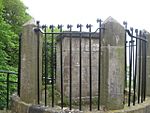Battle of Clachnaharry facts for kids
Quick facts for kids Battle of Clachnaharry |
|||||||
|---|---|---|---|---|---|---|---|
| Part of the Scottish clan wars | |||||||
 The Clachnaharry battle monument |
|||||||
|
|||||||
| Belligerents | |||||||
| Clan Munro | Clan Mackintosh | ||||||
| Commanders and leaders | |||||||
| John Munro | Mackintosh of Mackintosh | ||||||
| Strength | |||||||
| Unknown | Unknown | ||||||
| Casualties and losses | |||||||
| Unknown | 200 killed | ||||||
The Battle of Clachnaharry was an old Scottish clan battle. It happened in 1454 near Inverness, Scotland. The fight was between the Clan Munro and the Clan Mackintosh. It took place on the south side of the Beauly Firth, close to a place called Clachnaharry.
Contents
Why the Clans Fought
The Clan Munro warriors were heading home after a cattle raid in another area called Perthshire. As they passed through land controlled by the Clan Mackintosh, they were asked to pay a "road collop." This was like a toll or passage money, a common custom in the Scottish Highlands back then.
However, the two clans couldn't agree on how much money should be paid. This disagreement quickly turned into a big fight, leading to the Battle of Clachnaharry.
Stories of the Battle
Different historical accounts tell slightly different versions of what happened at Clachnaharry. The earliest story was written by Sir Robert Gordon in 1630. Later, the Mackintosh clan wrote their own account in 1679. Most stories you read today are based on Gordon's original version.
The Main Accounts
Historians have looked at several old writings to understand the battle:
- Sir Robert Gordon's Account (1630): Sir Robert Gordon wrote that John Munro, a leader from the Munro clan, was returning home. He had raided Strathardle and taken cattle. When he passed by Loch Moy, the chief of Clan Mackintosh demanded a share of the stolen goods. Munro offered some, but Mackintosh wanted half! Munro refused and kept going. Mackintosh then gathered his forces and caught up with Munro at Clachnaharry. Gordon says that Munro sent 50 of his men home with the cattle. A fierce battle followed, and Gordon claims the Mackintosh chief was killed. Many Munros also died, and John Munro was left for dead, but he survived.
- Wardlaw Manuscript (1674): This account, written by James Fraser, says the battle happened in 1378. It also mentions John Munro returning from a raid. The story is similar: Mackintosh demanded a share of the cattle, but they couldn't agree on the amount. Munro sent 50 men with the cattle to a safe place. Then, with his remaining 300 men, he fought the Mackintoshes. This account states that the Mackintosh chief, his brother, and his second son were killed. It also says about 200 Mackintosh men died. John Munro was wounded but found later and cared for by the Frasers of Lovat.
- Mackintosh of Kinrara (1679): This version, written by a Mackintosh, gives a different view. It says the fight in 1454 was between Malcolm Mackintosh (the chief's grandson) and John Munro. It agrees that John Munro was returning from a raid. Munro offered 24 cows and a bull, but Malcolm Mackintosh wanted a third of everything. Munro refused. This account claims that Malcolm Mackintosh was not actually present during the battle itself. It says only a few men fell on each side. John Munro was badly hurt but recovered with help from Lord Lovat. This account also mentions that Malcolm Mackintosh later married John Munro's sister, Janet.
Later Publications
Many later writers also wrote about the battle, often combining details from the earlier accounts:
- John Anderson (1825): He wrote that the Munros were returning from the south when the Mackintosh chief demanded a share of their cattle. The Munros refused, and a battle began at Clachnaharry. Anderson states that the Mackintosh chief was killed, and John Munro was left for dead. He was known as John Baclamhach because he lost an arm.
- William Anderson (1863): This account describes John Munro's horses having their tails cut off in Strathardle, leading to his revenge raid. It confirms the "road collop" demand and the battle at Clachnaharry. It says Mackintosh and most of his men were killed, and John Munro was wounded. It also mentions that the Munros had an advantage because they fought from among rocks, using arrows against the Mackintoshes.
- Mackintosh-Shaw (1880): This writer compared the different accounts. He pointed out that the Kinrara manuscript (from the Mackintosh side) says the chief's grandson, Malcolm Mackintosh, led the pursuit, not the chief himself. He also suggests that Malcolm Mackintosh arrived after the battle was over. Mackintosh-Shaw believed the losses were equal for both sides.
- Shaw (1882): This account also mentions the horse tails being cut off. It describes the "road collop" custom and the battle at Clachnaharry. Shaw states that the Laird of Mackintosh was killed and John Munro was wounded. He also highlights that the Munros used the rocky ground to their advantage, shooting arrows while the Mackintoshes were exposed.
Clachnaharry Monument
A special monument stands at Clachnaharry to remember this battle. It was built in 1821 by Major Hugh Robert Duff. The monument used to have a tall column, but it fell down in a storm in 1951. One side of the monument says "Munro" and the other side says "Chattan" (referring to the Mackintosh clan). These words face the traditional lands of each clan.




